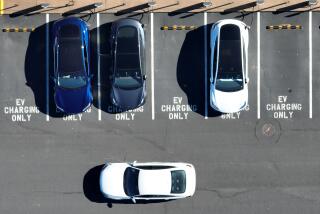Ford, Honda to Team on Electric Car Stations
DETROIT — Ford Motor Co. and Honda Motor Co. are expected to announce today that they will jointly provide $200,000 in funds to develop electric-vehicle-charging stations in California.
Ford and Honda are hoping to kick-start the development of public stations where motorists can “refuel” their batteries away from home. At present, such recharges are free.
The cooperative effort is also aimed at promoting a “conductive” charging system, which both auto makers favor over the “inductive” system advocated by General Motors Corp.
In May, GM spent $250,000 to build charging systems in Southern California. GM’s inductive system, however, isn’t compatible with electric vehicles made by Honda, Ford and some others.
Battle lines have been drawn over the last several years on which charging system will become the industry standard; auto makers say the winner will eventually be decided by consumers.
The contributions from Honda and Ford will be used for the installation of about 50 public charging stations at shopping malls, hospitals, airports and parking garages--which will be required to match the investment by Ford and Honda.
More charging stations are needed to quell consumer concerns about the limited driving range of electric vehicles. Honda’s EV-Plus, which went on sale in California in May, has a range of 60 to 80 miles per charge. Ford’s Ranger EV, which arrives at dealerships in December, is limited to about 50 miles.
Marty Friedman, head of strategy and planning for Ford’s alternative-fuel vehicles program, said a two-hour charge at a public station could increase an electric vehicle’s range by 50%.
“This demonstrates our belief that infrastructure is important,” Friedman said.
Edison EV, a unit of Edison International, will install the public charging stations. Currently there are 83 stations in Southern California and another 22 under development, it said.
The debate over inductive or conductive charging is often compared to the shakeout between Beta and VHS tapes in videocassettes. Both sides claim their charging systems are superior.
More to Read
Inside the business of entertainment
The Wide Shot brings you news, analysis and insights on everything from streaming wars to production — and what it all means for the future.
You may occasionally receive promotional content from the Los Angeles Times.










